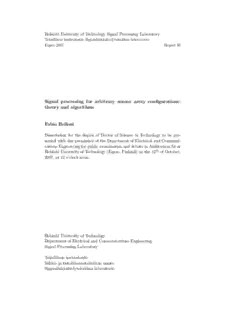
Signal processing for arbitrary sensor array configurations PDF
Preview Signal processing for arbitrary sensor array configurations
Helsinki University of Technology Signal Processing Laboratory Teknillinen korkeakoulu Signaalink¨asittelytekniikan laboratorio Espoo 2007 Report 60 Signal processing for arbitrary sensor array configurations: theory and algorithms Fabio Belloni Dissertation for the degree of Doctor of Science in Technology to be pre- sented with due permission of the Department of Electrical and Communi- cations Engineering for public examination and debate in Auditorium S4 at Helsinki University of Technology (Espoo, Finland) on the 12th of October, 2007, at 12 o’clock noon. Helsinki University of Technology Department of Electrical and Communications Engineering Signal Processing Laboratory Teknillinen korkeakoulu S¨ahk¨o- ja tietoliikennetekniikan osasto Signaalink¨asittelytekniikan laboratorio Distribution: Helsinki University of Technology Signal Processing Laboratory P.O. Box 3000 FIN-02015 TKK Finland Tel. +358-9-451 3211 Fax. +358-9-452 3614 E-mail: Mirja.Lemetyinen@tkk.fi Webpage: http://wooster.tkk.fi c Fabio Belloni (cid:13) ISBN 978-951-22-8969-1 (Printed) ISBN 978-951-22-8970-7 (Electronic) ISSN 1458-6401 Multiprint Espoo 2007 AB ABSTRACTOFDOCTORALDISSERTATION HELSINKI UNIVERSITY OF TECHNOLOGY P.O.BOX1000,FI-02015TKK http://www.tkk.fi Author FabioBelloni Nameofthedissertation SignalProcessingforArbitrarySensorArrayConfigurations: TheoryandAlgorithm Manuscriptsubmitted 25June,2007 Manuscriptrevised 31August,2007 Dateofthedefence 12October,2007 Monograph X Articledissertation(summary+originalarticles) Department ElectricalandCommunicationsEngineering Laboratory SignalProcessingLaboratory Fieldofresearch SensorArraySignalProcessing Opponent(s) Prof. MichaelD.Zoltowski(PurdueUniverity)andDr. KimmoKalliola(NokiaResearchCenter) Supervisor Prof. VisaKoivunen Instructor Dr. AndreasRichter Abstract Sensorarraysystemsareemployedinmanyapplicationareassuchasmulti-antennawirelesscommunications,radar andbiomedicine. Amongtheresearchareasofsensorarraysignalprocessing,theproblemoffindingthedirection-of- arrival(DoA)atwhichapropagatingwavefieldimpingesonasensorarrayisapopularresearchfield. Applications explicitlyneedingdirectionalinformationincludebeamforming,localization,surveillance,andchannelsounding. Mosthigh-resolutionandcomputationallyefficientsensorarrayprocessingalgorithmshavebeendevelopedforideal sensorarrayswithregulargeometryandknownsensorresponse. Inpractice,thegeometryofthearraycannotbecho- senfreelyandthearrayresponseisalwaysanunknownquantitywhichcanbeestimatedonlythroughnoisycalibration measurements. Consequently,theabovealgorithmsarenotapplicableonreal-worldarrayswitharbitraryconfiguration. Thisthesisfocusesonderivingandanalyzingnovelalgorithmsprovidinghigh-resolution,optimalorclosetooptimal statisticalperformance,andlowcomputationalcomplexity,despitetheantennaarraygeometryandimperfections. In particular,theproblemofreformulatingthearraysignalprocessingmodelsothatcomputationallyefficienthigh-reso- lutionDoAestimationalgorithmscanbeusedwithsensorarraysofarbitraryconfigurationisaddressed. Thecontribu- tionsinthisthesisareintheareasofarraytransformtechniques,antennamodelling,andsignalprocessingalgorithms usingsensorarraysofarbitraryconfigurations. Inthisthesis,thekeyideasandperformanceofthemostcommonarraytransformtechniquesareinvestigated. The transformationerrorsandtheirimpactontheDoAestimatesareanalyzed. Novelalgorithmsdevelopedforreducing thebiasandmitigatingtheexcessvarianceintheDoAestimatesareintroduced. Furthermore,analternativeapproach totheabovetechniquesknownasmanifoldseparationtechnique(MST)isanalyzed. TheintroducedMSTexploitsthe effectiveaperturedistributionfunction(EADF)anditisamethodformodellingtheazimuthalresponseofsensor arrayswitharbitraryconfigurationsbyusingVandermondestructuredmodels. AnovelMST-basedpolynomialrooting DoAalgorithmisproposedandtheeffectofnoisycalibrationdataonitsstatisticalperformanceisalsostudied. Implementationissuesandtheuseofthedevelopedtechniquesinreal-worldarraysarediscussedaswell. Keywords Directionofarrival(DoA)estimation,arraytransformtechniques,manifoldseparation,erroranalysis ISBN(printed) 978-951-22-8969-1 ISSN(printed) 1458-6401 ISBN(pdf) 978-951-22-8970-7 ISSN(pdf) Language English Numberofpages 169 Publisher HelsinkiUniversityofTechnology,SignalProcessingLaboratory Printdistribution HelsinkiUniversityofTechnology,SignalProcessingLaboratory X Thedissertationcanbereadathttp://lib.tkk.fi/Diss/2007/isbn9789512289707 AB VÄITÖSKIRJANTIIVISTELMÄ TEKNILLINENKORKEAKOULU PL1000,02015TKK http://www.tkk.fi Tekijä FabioBelloni Väitöskirjannimi Sensoriryhmiensignaalinkäsittelynteoriaajaalgoritmejageometrialtaanvapaavalintaisilleryhmille Käsikirjoituksenpäivämäärä 25June,2007 Korjatunkäsikirjoituksenpäivämäärä 31August,2007 Väitöstilaisuudenajankohta 12October,2007 Monografia X Yhdistelmäväitöskirja(yhteenveto+erillisartikkelit) Osasto ElectricalandCommunicationsEngineering Laboratorio SignalProcessingLaboratory Tutkimusala SensorArraySignalProcessing Vastaväittäjä(t) Prof. MichaelD.Zoltowski(PurdueUniverity)andDr. KimmoKalliola(NokiaResearchCenter) Työnvalvoja Prof. VisaKoivunen Työnohjaaja Dr. AndreasRichter Tiivistelmä Sensoriryhmiinperustuviajärjestelmiähyödynnetäänmonillaerisovellusalueilla,kutenradiotietoliikenteenälyanten- nijärjestelmissä,tutkatekniikassasekälääketieteellisissämittauksissa. Sensoriryhmiensignaalinkäsittelynosa-alueista signaalientulosuunnan(DoA)estimointionkeskeisimpiätutkimusaiheita. Sovelluksia,jotkatarvitsevatyksikäsitteistä suuntatietoa,ovatesimerkiksikeilanmuodostus,paikantaminen,valvontasovellukset,navigointijakanavaluotaus. Useimmatlaskennallisestitehokkaistasensoriryhmienkorkearesoluutioalgoritmeistaonkehitettyideaalisillesensori- ryhmille,joidengeometriaonsäännöllinenjasensorienvasteontunnettu. Käytännössägeometriaaeikuitenkaanvoida valitavapaastijavasteetsisältävätainasuureita,jotkaovatainoastaanestimoitavissakalibrointimittauksista. Tästä johtuenedellämainitutalgoritmiteivättyypillisestiolesuoraansovellettavissareaalimaailmansensoriryhmiin. Tässäväitöskirjassajohdetaanjaanalysoidaanuusiaalgoritmeja,joidentavoitteinaovatkorkearesoluutio,tilastollises- tioptimaalinentailähesoptimaalinensuorituskyky,sekälaskennallinentehokkuussensoriryhmiengeometriastaja epäideaalisuuksistariippumatta. Erityistähuomiotakiinnitetäänsensoriryhmiensignaalinkäsittelymallienmuokkaami- seensiten,ettävoidaanhyödyntäälaskennallisestitehokkaitasuunnanestimointialgoritmejamielivaltaisiinsensori- ryhmienkokoonpanoihin. Työnpäätuloksiaovatuudetlaskennallisetmuunnostekniikat,antenniryhmämallitja signaalinkäsittelyalgoritmitmielivaltaisillesensoriryhmänkokoonpanoille. Tässätyössäkäydäänläpiyleisimpienantenniryhmiensignaalinkäsittelyssäkäytettävienlaskennallistenmuunnostek- niikoidenperiaatteetjasuorituskyky. Muunnostenaiheuttamiavirheitäjaniidenvaikutustasuunnanestimoinninsuori- tuskykyynanalysoidaan. Työssäkehitetäänuusiaalgoritmejaestimointiharhanjasuuntaestimaattienvarianssinpienen- tämiseksi. LisäksikehitetäänvaihtoehtoinenMST-periaateeseen(ManifoldSeparationTechnique)perustuvamenetel- mä. MST-tekniikkahyödyntääefektiivistäapertuurinjakaumafunktiota(EADF)jamallintaasensoriryhmienkulma- vastettamielivaltaisillakokoonpanoillaVandermonde-rakenteisenmallinavulla. TyössäjohdetaanuusiMST-pohjainen polynomijuuriinperustuvatulosuunnanestimointialgoritmijatutkitaankohinaisenkalibrointitiedonvaikutustasenti- lastolliseensuorituskykyyn. Myöstekniikoidensoveltuvuuttajatoteutettavuuttatodellisillaantenniryhmilläarvioidaan. Asiasanat Suunnanestimointi,muunnostekniikat,manifoldseparation,virheanalyysi,antennienkalibrointi ISBN(painettu) 978-951-22-8969-1 ISSN(painettu) 1458-6401 ISBN(pdf) 978-951-22-8970-7 ISSN(pdf) Kieli Englanti Sivumäärä 169 Julkaisija HelsinkiUniversityofTechnology,SignalProcessingLaboratory Painetunväitöskirjanjakelu HelsinkiUniversityofTechnology,SignalProcessingLaboratory X Luettavissaverkossaosoitteessahttp://lib.tkk.fi/Diss/2007/isbn9789512289707 Acknowledgements The research work for this doctoral thesis was carried out in the Signal ProcessingLaboratory,HelsinkiUniversityofTechnology(TKK),duringthe years 2003–2007. The Statistical Signal Processing group, led by Prof. Visa Koivunen, is a part of SMARAD (Smart and Novel Radio Research Unit) Center of Excellence in research nominated by the Academy of Finland. First, I wish to express my sincere gratitude to my thesis advisor Prof. Visa Koivunen for his continuous encouragement, guidance, and constant support during the course of this work. I also want to express my sincere gratitude to Dr. Andreas Richter for this guidance and friendship. It has beenanhonortoworkwithsuchdeeplydedicatedscientists. Thediscussions I had with Prof. Koivunen and Dr. Richter, their comments, suggestions, and constructive criticism have greatly contributed to the technical quality of the thesis. I would like to thank the thesis pre-examiners, Prof. Sergiy Vorobyov and Prof. Magnus Jansson, for their constructive comments that helped to improve the final version of the manuscript. Furthermore, Prof. Iiro Har- timo, the former director of the Graduate School in Electronics, Telecom- munications and Automation (GETA) and the GETA coordinator Marja Lepp¨aharju deserve many thanks. The work of the laboratory secretaries, Anne J¨aa¨skela¨inen and Mirja Lemetyinen, in assisting and helping me with all practical issues and arrangements is also highly acknowledged. I would like to thank all the colleagues at the Signal Processing Labora- tory for having created such a nice working atmosphere. In particular, I am gratefultoM.Sc. TraianAbrudan, Dr. JanEriksson, Dr. MaaritMelvasalo, Dr. Timo Roman, M.Sc. Jussi Salmi, and M.Sc. Eduardo Zacarias for all the constructive and relaxing discussions. This research work was funded by the Academy of Finland (TULE pro- gram), the Finnish Defence Forces Technical Research Center (PvTT), and the GETA graduate school. Also, the financial support of Tekniikan edist¨a- miss¨aa¨ti¨o(TES),NokiaandWihurifoundations, isgratefullyacknowledged. I wish to express my sincere gratitude to my parents, Luciano and Ilva, and my sister Veronica for their love, constant support, and encouragement during all this time. I also would like to thank my Finnish family, in partic- ular Lila, Eino and Kalle, for welcoming me into their lives and for caring v about me. In addition, I would like to thank my friends Daniel, Anna, Jean- Luc, and Hanna for their genuine friendship. Also all my friends in Italy deserve a special thank for having always made me feel close to them. Finally, I haven’t got enough words for thanking my dear wife Kaisa for her love, close support and encouragement and for having recently given me a beautiful daughter, Lilja, who brought so much more love and happiness to my life. Espoo, September 2007 Fabio Belloni vi To Kaisa and Lilja vii viii
Description: